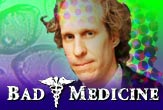The Truth Behind the Spinach Scare: Cheap Beef

When in Mexico, the saying goes, don't drink the water. You shouldn't eat the spinach either because it could be contaminated with the E. coli strain that has sickened close to 200 people in the United States and killed at least one, likely more.
The problem is our food production system is so complex that most of us cannot be certain where our food comes from. Even the U.S. government, after two weeks on the case of the spinach E. coli outbreak, has narrowed the source to, oh, somewhere in central California.
Gee, you think? California produces about three-fourths of the nation's fresh spinach, and Salinas Valley accounts for about three-fourths of that. These guys are sharp. But they aren't looking closely enough.
There are two ways for the U.S. government to greatly minimize the risk of an E. coli outbreak: start supporting local farming and stop mass-producing cattle, the true source of E. coli. Neither will happen soon, however, because it infringes on the American pursuit of cheap, crappy food.
You excrete billions
E. coli, short for Escherichia coli, is a bacterium with hundreds of strains, most of which are relatively harmless in healthy individuals. E. coli is ubiquitous is the guts of cows and humans and is spread from cow to cow and from human to human through feces.
Humans excrete billions of E. coli bacteria with each bowel movement, which is why hand-washing is so important.
Sign up for the Live Science daily newsletter now
Get the world’s most fascinating discoveries delivered straight to your inbox.
Cows don't have the luxury of hand-washing. When they are cramped into pens, ankle-deep in the manure of hundreds to thousands of cows, E. coli tends to spread. Bacteria can splash up on udders and get into milk; or get into intestines and contaminate meat during the slaughtering process; or pass through the cow in manure and ultimately end up on crops directly as fertilizer or indirectly by leaching into the water supply.
Most E. coli outbreaks in the United States are caused by a particular virulent and deadly strain called O157:H7. If you eat, you are at risk.
Meat eaters are at risk because most beef is loaded with harmful bacteria, often the bad E. coli, and needs to be cooked. Vegetarians aren't spared, as evidenced by the spinach E. coli outbreak. Organic consumers aren't spared; organic spinach can have E. coli. And raw food advocates are most certainly at risk, because cooking is the best way to kill the bacteria.
Local food is best
It's September. Every state in the union can grow spinach. In fact, spinach is largely a cool-weather spring and fall crop. Why is California growing all of our spinach?
At work are the perverse forces of economic markets, not the forces of nature. The U.S. food production system has been fined-tuned to maximize profits for a small group of farmers, often corporations, holding vast acres of land.
Spinach from small, local farms could very well be contaminated with E. coli O157:H7. It simply wouldn't spread to other states, or to other cities for that matter. Health authorities would be able to identify the source of the bad E. coli within hours. And tons of safe spinach sold around the country wouldn't need to be recalled "just in case," as is the case now.
Small-scale farming inherently means fewer hands and fewer opportunities for contamination---bacterial, viral or parasitic---from field to fork. So while the small, local guys aren't immune to the kind of contamination problems that plague the big guys, the odds are in their favor.
Big, fat cows
While some food safety experts are unfairly bashing organic farmers and their reliance on manure for fertilizer, the real culprit behind E. coli outbreaks is the industrial beef and cattle industry. First, certified organic farmers are prohibited from using raw manure for 90 days before harvest of food for humans. Second, most organic farmers compost their manure, which kills most E. coli.
Industrial beef and dairy farms are disease-ridden cesspools. A growing body of evidence suggests that corn-fed cattle have higher counts of E. coli O157:H7 compared to free-range, grass-fed cattle, which seem largely free from this bacterium. The reason is twofold: Free-rangers come in less contact with each others' manure compared to stressed-out cattle packed in feeding lots; and corn makes the cow's stomach juices more acidic, which gives rise to the acid-loving O157:H7 strain.
Also, mega-farms cannot get rid of their tons of O157:H7-rich manure. This sits in cesspools and ultimately contaminates the surrounding environment.
Switching back to free-range, grass-fed cattle would solve this problem. But beef would be more expensive, and some view this as a bad thing despite the epidemic of obesity and diabetes and the clear link between high beef consumption and colon cancer.
Zap those buggers
Look for Band-Aid solutions touted in the weeks to come, such as irradiation, with its cute, deceptive nickname of cold pasteurization. Irradiation entails zapping food with gamma rays, X-rays or electrons to deactivate harmful bacteria along with other stuff helpful in the food, like vitamins.
But with the unnatural process of irradiation, we can continue the unnatural but cheap practice of feeding cows corn, which they can't digest, so we can continue the unnatural process of consuming lots and lots of this modern invention called the cow.
Then maybe we can counter any adverse human health effects with expensive surgery or drug therapy. It's the American way.
Christopher Wanjek is the author of the books “Bad Medicine” and “Food At Work.” Got a question about Bad Medicine? Email Wanjek. If it’s really bad, he just might answer it in a future column. Bad Medicine appears each Tuesday on LIveScience.
Related Stories
More to Explore
- The Biggest Popular Myths
- Top 10 Mysterious Diseases
- Urban Legends Debunked

Christopher Wanjek is a Live Science contributor and a health and science writer. He is the author of three science books: Spacefarers (2020), Food at Work (2005) and Bad Medicine (2003). His "Food at Work" book and project, concerning workers' health, safety and productivity, was commissioned by the U.N.'s International Labor Organization. For Live Science, Christopher covers public health, nutrition and biology, and he has written extensively for The Washington Post and Sky & Telescope among others, as well as for the NASA Goddard Space Flight Center, where he was a senior writer. Christopher holds a Master of Health degree from Harvard School of Public Health and a degree in journalism from Temple University.










